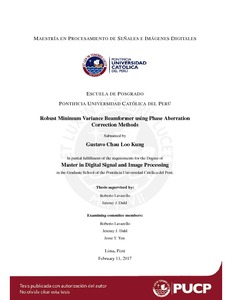| dc.contributor.advisor | Lavarello Montero, Roberto Janniel | |
| dc.contributor.advisor | Dahl, Jeremy J. | |
| dc.contributor.author | Chau Loo Kung, Gustavo Ramón | es_ES |
| dc.date.accessioned | 2017-04-28T01:19:54Z | es_ES |
| dc.date.available | 2017-04-28T01:19:54Z | es_ES |
| dc.date.created | 2017 | es_ES |
| dc.date.issued | 2017-04-28 | es_ES |
| dc.identifier.uri | http://hdl.handle.net/20.500.12404/8498 | |
| dc.description.abstract | The minimum variance (MV) beamformer is an adaptive beamforming method that has the potential
to enhance the resolution and contrast of ultrasound images. Although the sensitivity of the MV
beamformer to steering vector errors and array calibration errors is well-documented in other fields, in
ultrasound it has been tested only under gross sound speed errors. Several robust MV beamformers
have been proposed, but have mainly reported robustness only in the presence of sound speed mismatches.
Additionally the impact of PAC methods in mitigating the effects of phase aberration in MV
beamformed images has not been observed
Accordingly, this thesis report consists on two parts. On the first part, a more complete analysis
of the effects of different types of aberrators on conventional MV beamforming and on a robust MV
beamformer from the literature (Eigenspace-based Minimum Variance (ESMV) beamformer) is carried
out, and the effects of three PAC algorithms and their impact on the performance of the MV beamformer
are analyzed (MV-PC). The comparison is carried out on Field II simulations and phantom experiments
with electronic aberration and tissue aberrators. We conclude that the sensitivity to speed of sound
errors and aberration limit the use of the MV beamformer in clinical applications, and that the effect
of aberration is stronger than previously reported in the literature. Additionally it is shown that under
moderate and strong aberrating conditions, MV-PC is a preferable option to ESMV.
On the second part, we propose a new, locally-adaptive, phase aberration correction method (LAPAC)
able to improve both DAS and MV beamformers that integrates aberration correction for each point in
the image domain into the formulation of the MV beamformer. The new method is tested using fullwave
simulations of models of human abdominal wall, experiments with tissue aberrators, and in vivo
carotid images. The LAPAC method is compared with conventional phase aberration correction with
delay-and-sum beamforming (DAS-PC) and MV-PC. The proposed method showed between 1-4 dB
higher contrast than DAS-PC and MV-PC in all cases, and LAPAC-MV showed better performance
than LAPAC-DAS. We conclude that LAPAC may be a viable option to enhance ultrasound image
quality of both DAS and MV in the presence of clinically-relevant aberrating conditions. | es_ES |
| dc.description.uri | Tesis | es_ES |
| dc.language.iso | eng | es_ES |
| dc.publisher | Pontificia Universidad Católica del Perú | es_ES |
| dc.rights | Atribución-NoComercial-SinDerivadas 2.5 Perú | * |
| dc.rights | info:eu-repo/semantics/openAccess | es_ES |
| dc.rights.uri | http://creativecommons.org/licenses/by-nc-nd/2.5/pe/ | * |
| dc.subject | Procesamiento de imágenes digitales | es_ES |
| dc.subject | Procesamiento de señales biomédicas | es_ES |
| dc.subject | Ultrasonido en medicina | es_ES |
| dc.subject | Diagnóstico por imágenes | es_ES |
| dc.title | Robust Minimmun Variance Beamformer using Phase Aberration Correction Methods | es_ES |
| dc.type | info:eu-repo/semantics/masterThesis | es_ES |
| thesis.degree.name | Magíster en Procesamiento de Señales e Imágenes Digitales. | es_ES |
| thesis.degree.level | Maestría | es_ES |
| thesis.degree.grantor | Pontificia Universidad Católica del Perú. Escuela de Posgrado | es_ES |
| thesis.degree.discipline | Procesamiento de Señales e Imágenes Digitales | es_ES |
| renati.advisor.dni | 10544227 | |
| renati.discipline | 613077 | es_ES |
| renati.level | https://purl.org/pe-repo/renati/level#maestro | es_ES |
| renati.type | http://purl.org/pe-repo/renati/type#tesis | es_ES |
| dc.publisher.country | PE | es_ES |
| dc.subject.ocde | https://purl.org/pe-repo/ocde/ford#2.02.05 | es_ES |






